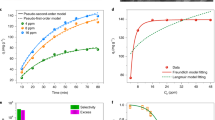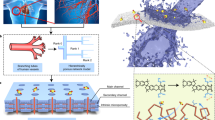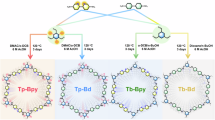Abstract
One strategy that is being pursued to tackle the international problem of actinide contamination of soils, sediments and water is to use microbial activity to 'fix' these radionuclides into an insoluble form that cannot be readily dispersed. Here we show that uraninite (UO2) particles formed from uranium in sediments by bacterial reduction are typically less than 2 nanometres across and that the small size has important implications for uraninite reactivity and fate. Because these tiny particles may still be transported in an aqueous environment, precipitation of uranium as insoluble uraninite cannot be presumed to immobilize it.
This is a preview of subscription content, access via your institution
Access options
Subscribe to this journal
Receive 51 print issues and online access
$199.00 per year
only $3.90 per issue
Buy this article
- Purchase on SpringerLink
- Instant access to full article PDF
Prices may be subject to local taxes which are calculated during checkout

Similar content being viewed by others
References
Lovely, D. R., Phillips, E. J. P., Gorby, Y. A. & Landa, E. R. Nature 350, 413–416 (1991).
Grenthe, I. et al. Chemical Thermodynamics of Uranium (Nuclear Energy Agency, North-Holland, The Netherlands, 1992).
Bond, P. L., Smriga, S. P. & Banfield, J. F. Appl. Environ. Microbiol. 66, 3842–3849 (2000).
Rai, D., Felmy, A. R. & Ryan, J. L. Inorg. Chem. 29, 260–264 (1990).
Author information
Authors and Affiliations
Ethics declarations
Competing interests
The authors declare no competing financial interests.
Rights and permissions
About this article
Cite this article
Suzuki, Y., Kelly, S., Kemner, K. et al. Nanometre-size products of uranium bioreduction. Nature 419, 134 (2002). https://doi.org/10.1038/419134a
Issue date:
DOI: https://doi.org/10.1038/419134a
This article is cited by
-
Deep anoxic aquifers could act as sinks for uranium through microbial-assisted mineral trapping
Communications Earth & Environment (2023)
-
Bioremediation potential of hexavalent chromium-resistant Arthrobacter globiformis 151B: study of the uptake of cesium and other alkali ions
International Microbiology (2022)
-
Electrochemical sensor for uranium monitoring in natural water based on poly Nile blue modified glassy carbon electrode
Journal of Solid State Electrochemistry (2022)
-
Cumulative Ordinary Kriging interpolation model to forecast radioactive fallout, and its application to Chernobyl and Fukushima assessment: a new method and mini review
Environmental Science and Pollution Research (2022)
-
Nanoscale mechanism of UO2 formation through uranium reduction by magnetite
Nature Communications (2020)



